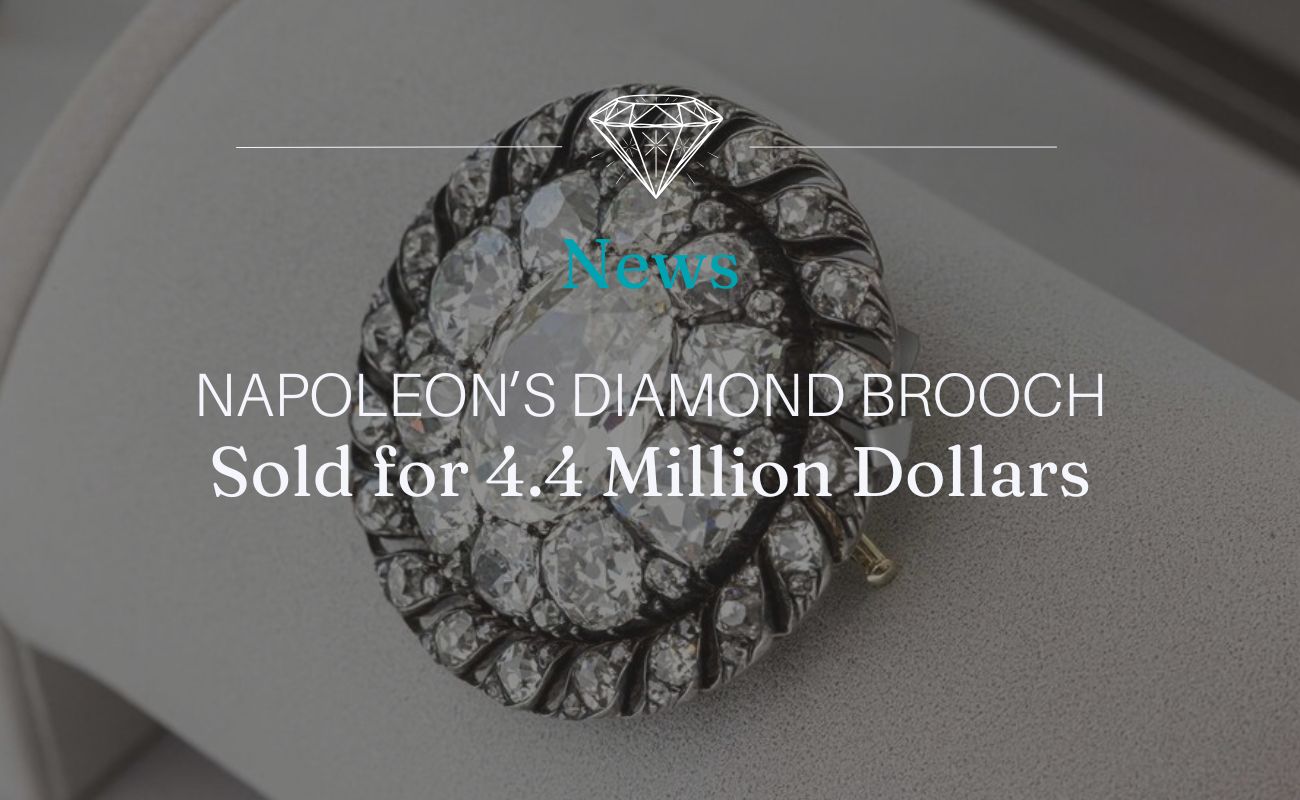Jewellery
Napoleon’s Diamond Brooch: An Imperial Treasure Sold for 4.4 Million Dollars

Historical jewelry fascinates as much as it intrigues. Such pieces carry the beauty of an era’s craftsmanship, but also the secrets, passions, and dramas of those who once owned them. Among these rare jewels that have crossed the centuries, the diamond brooch attributed to Napoleon Bonaparte stands out as truly exceptional. Kept in the shadows for nearly two centuries, it resurfaced during an auction organized by Sotheby’s in Geneva. Its spectacular journey,marked by conquests, defeats, and European dynasties, captivated collectors and ultimately sent its final price soaring.
Initially estimated between $150,000 and $250,000, it finally sold for $4.4 million, or 22 times its original estimate. A record that underscores the extraordinary aura of this imperial jewel.
A masterpiece of jewelry: brilliance, proportions, and imperial refinement
Created around 1810, at the height of the Napoleonic Empire, this diamond brooch reflects the imperial style—bold, majestic, and unmistakably designed to display power. At its center lies an exceptional oval diamond of 13.04 carats. Its antique cut, highly sought after today, gives the stone that distinctive fire found in diamonds from the 18th and 19th centuries.
Around this central gem, nearly 100 old mine–cut diamonds form a scintillating crown. The entire piece measures approximately 45 mm in diameter, making it an imposing and luxurious jewel, typical of the ornaments worn at the imperial court. The master jewelers of the time knew how to combine visual power with perfect proportions, and this brooch is a flawless example of their artistry.
Beyond its brilliance, it is also a precious witness to the cutting techniques of its era. Old mine–cut diamonds, predominant before the advent of modern cutting styles, play with the light in a softer, warmer, and almost romantic way. A contrast that enhances the historical character of the piece.
A story worthy of a novel: Napoleon, Waterloo, and the Hohenzollerns
Like all great jewels that survive the centuries, this brooch carries a history as captivating as the most romantic tales.
A jewel created for Napoleon or for the imperial entourage
Dated to around 1810, it was likely commissioned during the Empire’s final years of splendor. Napoleon placed immense importance on regalia, jewels, swords, ornaments, tools of political influence as much as objects of beauty. Whether the brooch belonged to him personally or was gifted to someone in his close circle, it was clearly created to embody imperial authority.
From imperial splendor to the disaster of Waterloo
The brooch’s fate changed dramatically in 1815, during Napoleon’s defeat at Waterloo. The carriages containing the Emperor’s and the army’s personal belongings were seized amid the chaos of the retreat. Among these possessions were several valuable items taken by the Prussian army—including this diamond brooch.
A treasure that entered the House of Hohenzollern
After its capture, the jewel became part of the Prussian royal collection, owned by the Hohenzollerns, one of Europe’s oldest ruling dynasties. Preserved for nearly a century, the brooch then followed a discreet path, likely passing through prestigious private collections.
This pedigree, Napoleon, Waterloo, Prussia, royalty, is one of the most impressive one can encounter in the world of historical jewelry. It is this impeccable chain of provenance that gives the brooch its incomparable cultural value.

AFP/Pierre Albouy
A record-breaking auction: $4.4 million for an imperial treasure
When Sotheby’s presented it during the “Royal & Noble Jewels” sale in Geneva, excitement spread instantly. Experts knew the brooch had strong potential, but no one expected such an outcome: within minutes, the bids skyrocketed, far exceeding initial estimates.
The final result, $4.4 million, illustrates several major trends in today’s market:
The value of provenance
A jewel linked to Napoleon and the Prussian royal family is an exceptionally rare object. Collectors are willing to bid extraordinarily high to acquire a piece of history.
The growing appeal of historical diamonds
Antique cuts, long overshadowed by modern faceting styles, are experiencing a spectacular revival. Their unique charm, organic shapes, and warm fire attract a new generation of enthusiasts.
The boom in noble and aristocratic jewelry
Sotheby’s and Christie’s have noted in recent years a massive resurgence of interest in imperial, royal, and aristocratic jewels. Napoleon’s brooch is now one of the most iconic examples of this trend.
Why does this brooch still fascinate today?
Beyond its exceptional beauty, what moves the public is the fusion of history and diamond. Jewelry has a unique ability to embody a moment, a reign, an event. This brooch alone evokes:
- the splendor of the imperial court
- the fall of Napoleon
- rivalries between nations
- the secret transfers of royal collections
- the fortunate rediscovery of a forgotten treasure
Sotheby’s experts remind us: provenance can multiply a jewel’s value many times over. In this case, it is what transformed a precious object into a coveted imperial symbol.
What this sale reveals about the antique diamond market
This record-setting auction confirms several key trends:
1. Old mine–cut diamonds are experiencing a major renaissance
More organic and more distinctive in their faceting, they appeal to collectors who value history and unique pieces.
2. Heritage jewelry far surpasses contemporary creations
Their value lies not in fashion but in the rarity and legacy they embody.
3. Storytelling has become essential
A jewel with a strong narrative sees its value explode. And when that story involves Napoleon, Waterloo, and a royal dynasty, success is guaranteed.
Conclusion: a jewel that has crossed empires and centuries
The diamond brooch known as “Napoleon’s brooch” embodies everything that makes historical jewelry so enchanting, beauty, power, legend, and mystery. Its journey, from the splendor of the Empire to the auction rooms of Geneva, illustrates the diamond’s ability to survive revolutions, defeats, and centuries.
Its record price of $4.4 million reflects not only its quality or rarity, but above all the deep fascination we still hold for Napoleonic history and the grandeur of imperial jewels.
One jewel, one battle, one dynasty, one auction, and now, a legend.